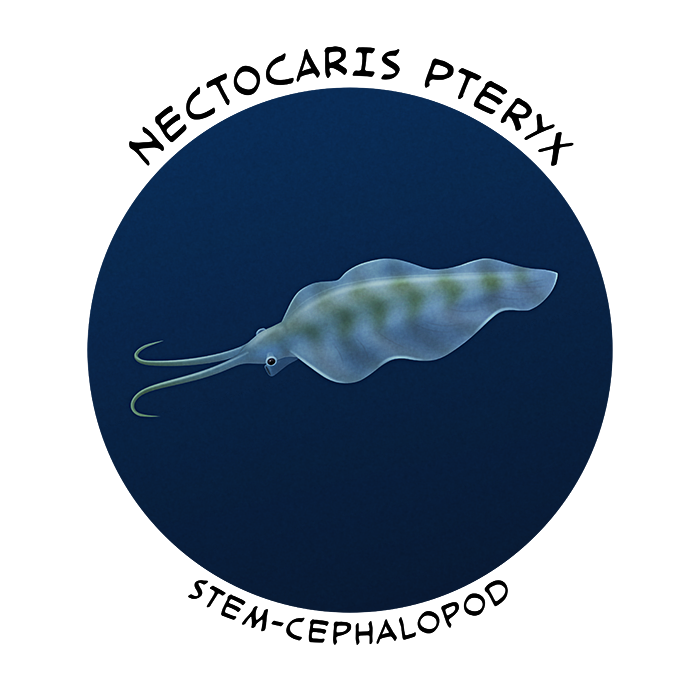Cephalopods‘ highly distinctive body plan and incredible intelligence make them some of the most charismatic marine animals. Today they’re mainly represented by the soft-bodied coleoids (octopuses, squid, and cuttlefish), with the modern giant squid and colossal squid being the largest living invertebrates. In comparison the shelled nautiluses seem like weird oddballs, but they’re actually far more typical examples of the group than their squishier cousins – as part of the conchiferan lineage the ancestors of all modern cephalopods were also shell-bearing molluscs, and for much of their evolutionary history shelled forms like ammonites and orthoceridans were extremely abundant.
The exact evolutionary relationships of cephalopods within the conchiferan family tree aren’t clear, but their closest relatives might be modern monoplacophorans and they probably descended from limpet-like “monoplacophoran-grade” ancestors in the early Cambrian. The current oldest potential cephalopod fossils come from about 522 million years ago, but the first definite cephalopods in the fossil record come from much later in the period.

Plectronoceras cambria was a tiny early nautiloid, known from the Late Cambrian of eastern China (~490-485 million years ago). Its shell was about 2cm long (0.8″) and it had the characteristic features of cephalopod phragmocones – chambers, septa, and a siphuncle.
This suggests it had internal air spaces reducing the density of its shell and acting as a buoyancy control mechanism, but its shell shape also indicates it wasn’t adapted for jet-powered swimming like later cephalopods. Instead it may have mostly crawled around on the sea floor, while also being able to float up vertically into the water column either to avoid predators or to access new food sources.
But there’s a complication in the simple-seeming story of shelled ancestral cephalopods learning to float, and its name is Nectocaris pteryx.

Known from the Canadian Burgess Shale fossil deposits (~508 million years ago), the Australian Emu Bay Shale (~514 million years ago), and the Chinese Chengjiang fossil deposits (~518 million years ago), this animal had a surprisingly squid-like body with fleshy fins, two tentacles, stalked eyes, a siphon-like funnel, and no sign of a shell.
It also came in two different “size morphs”, one about 3cm long (1.2″) and the other about 10cm long (4″), which might represent sexual dimorphism.
For a long time it was known from only a single incomplete fossil from the Burgess Shale, with uncertain classification and strange-looking attempted reconstructions. But in 2010 many more better-preserved fossils revealed that Nectocaris seemed to be some sort of early soft-bodied cephalopod, pre-dating early nautiloids like Plectronoceras by almost 30 million years.
It’s generally thought to be a member of a short-lived stem lineage that diverged early on in the groups’ history, convergently losing their shells and developing a resemblance to modern coleoids – a sort of early “experiment” in coleoid-like fast active swimming, but which ultimately failed and didn’t happen again until the true coleoids evolved a couple of hundred million years later.
…Except there’s now yet another twist.
The recently-discovered Nectocotis rusmithi is a nectocaridid from Late Ordovician deposits in the state of New York, USA, dating to about 450 million years ago. It demonstrates that these early cephalopods survived for much longer than previously thought, and even made it through the end-Cambrian extinction event that wiped out all but one lineage of the shelled cephalopods.
And it had an internal shell – but made of a tough non-mineralized substance rather than calcium carbonate.
This brings up a couple of interesting evolutionary possibilities:
- Nectocaridids might still be a weird early convergently-squid-like side branch of cephalopod evolution that internalized their shells, with Nectocaris losing the shell completely while Nectocotis retained a non-mineralized version.
- Or, shells might have actually been non-mineralized (and possibly also internal) from the start in ancestral cephalopods – potentially explaining the lack of earlier Cambrian fossils. Early forms were Nectocaris-like active swimmers with a high metabolic rate, and nautiloids like Plectronoceras evolved from them during the late Cambrian when oxygen levels were dropping and such high levels of activity were less sustainable, developing mineralized external shells with energy-saving passive buoyancy and lower metabolisms.
